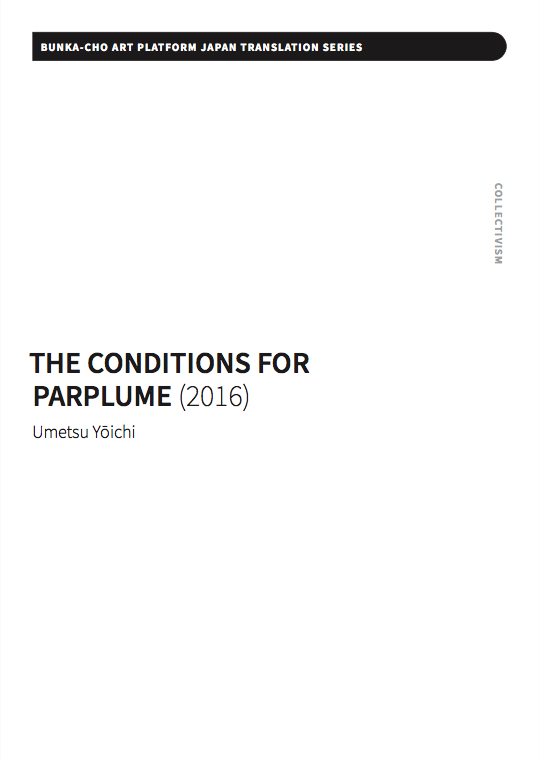The Conditions for Parplume
Umetsu Yōichi
R202010

In this paper, artist Umetsu Yōichi (b. 1982) describes how he came to launch the art collective Parplume and delves into issues that have informed his efforts to foster a larger arts movement. Umetsu has headed Parplume since 2014.
He begins by problematizing the teaching methods at art schools in Japan, particularly their emphasis on dessin. A perennial element of the nation’s art school entrance exams, Umetsu posits dessin as an anachronistic vestige of the French academy, imported in the late nineteenth century by the painter Kuroda Seiki. Umetsu next identifies specific examples of how these pedagogical techniques have shaped the work of contemporary artists, underscoring the heretofore oft-overlooked influence of “entrance-exam art” on artistic practice in Japan. Umetsu also points out the irony of artists who themselves criticize the pedagogical systems exemplified by plaster dessin, while still being complicit in perpetuating the status quo as professors at the nation’s art schools of repute.
This milieu set the stage for Parplume. As Umetsu explains, “Parplume emerged at a point when prep schools found themselves on the verge of extinction, having ceased to be commercially viable, and [our] intention was to return to the origin of the prep school, namely, the private painting studio.” Employing diverse mediums running the gamut from publications to gallery exhibitions, Parplume embraces the covalent interrelation. His live-in atelier provides a space where a diverse cast of artists can commingle and create new work. Blurring the line between action and result, Umetsu evokes how Parplume is metamorphosing into a new platform whose members not only work together, but also co-exist as a collective.
In addition to shining an important critical light on the pedagogical systems supporting contemporary Japanese art, this paper could perhaps could also be read as a manifesto, offering valuable insights into Umetsu as both a modern-day steward of fine art education in Japan post-Kuroda, as well as the champion of a new movement of his own.
- Title
- The Conditions for Parplume
- Author
- Umetsu Yōichi
- First published
- 2016
- Translation
- Polly Barton
- Editing
- Andrew Maerkle, Rachi Akira
- Design
- Ian Lynam
- Theme
- Collectivism
- First Posted Online
- 2021-03-15
- Last modified
- 2021-03-15
© 2021 Umetsu Yōichi + Bunka-cho Art Platform Japan
The "Readings" or the newly published English translations on this website (https://artplatform.go.jp) can be used without permission only for the purposes of education, research, critique, survey, and the like. English translations cannot be copied for the purpose of sale or distribution. You must comply with the Rules Governing the Use of the English Translations.
- Citation
- Footnote/endnote: Umetsu Yōichi, "The Conditions for Parplume," trans. Polly Barton, Bunka-cho Art Platform Japan, posted March 15, 2021, artplatform.go.jp/readings/R202010.
Bibliography: Umetsu Yōichi. "The Conditions for Parplume." Translated by Polly Barton. Bunka-cho Art Platform Japan. Posted March 15, 2021. artplatform.go.jp/readings/R202010. - Original Japanese Edition
- Umetsu Yōichi, “Hihyō: Pāpurūmu no jyōken,” Rear, no. 36 (2016): 138–42.
梅津庸一「批評 パープルームの条件」、『REAR = リア : 芸術批評誌』36巻(2016年1月)、138–142頁。 - National Diet Library(NDL)
- https://id.ndl.go.jp/bib/027553002
- ISBN
